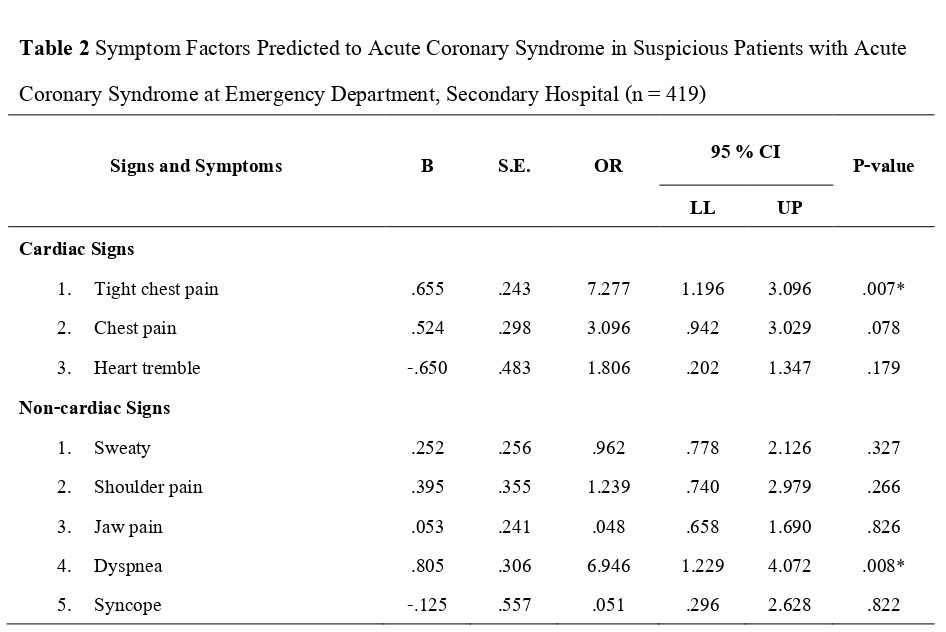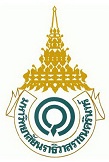ปัจจัยทำนายด้านอาการในผู้ที่สงสัยการเกิดภาวะหัวใจขาดเลือดเฉียบพลัน ที่เข้ารับการรักษา ณ แผนกฉุกเฉิน โรงพยาบาลระดับทุติยภูมิ
คำสำคัญ:
ภาวะหัวใจขาดเลือดเฉียบพลัน, แผนกฉุกเฉิน, อาการ, ปัจจัยทำนายบทคัดย่อ
การวิจัยความสัมพันธ์เชิงทำนายนี้มีวัตถุประสงค์เพื่อศึกษาปัจจัยทำนายด้านอาการผู้ป่วยที่สงสัยการเกิดภาวะหัวใจขาดเลือดเฉียบพลัน ที่เข้ารับการรักษา ณ แผนกฉุกเฉิน โรงพยาบาลระดับทุติยภูมิ คัดเลือกกลุ่มตัวอย่างแบบเฉพาะเจาะจง โดยเป็นผู้ป่วยที่สงสัยว่ามีภาวะหัวใจขาดเลือดเฉียบพลัน อายุ 35 ปีขึ้นไป จำนวน 419 คน เก็บรวบรวมข้อมูลโดยการสัมภาษณ์ เครื่องมือที่ใช้ในการเก็บรวบรวมข้อมูล ได้แก่ แบบบันทึกข้อมูลทั่วไป แบบบันทึกอาการ 15 อาการ แบบบันทึกข้อมูลทางคลินิก และวิเคราะห์ข้อมูลโดยใช้สถิติเชิงพรรณนา,ไคสแควร์, และการวิเคราะห์ถดถอยโลจิสติกแบบทวิภาค
ผลการวิจัยพบว่า ร้อยละ 62.53 ของกลุ่มตัวอย่างเกิดภาวะหัวใจขาดเลือดเฉียบพลัน โดยอาการเจ็บแน่นหน้าอก (OR = 1.924, 95 % CI 1.196 – 3.096, p = .007) หายใจหอบลึก หายใจไม่อิ่ม
(OR = 2.237, 95 % CI 1.229 – 4.072, p = .008) อาการปวดจุกแน่นลิ้นปี่และท้องส่วนบน (OR = .275, 95 % CI 0.133 – 0.567, p < .001) อาการอ่อนเพลีย / วิงเวียนศีรษะ (OR = 2.650, 95 % CI 1.367 – 5.140, p =.004) สามารถทำนายการเกิดภาวะหัวใจขาดเลือดเฉียบพลันอย่างมีนัยสำคัญทางสถิติที่p < .05 และสามารถร่วมกันทำนายการเกิดภาวะหัวใจขาดเลือดเฉียบพลันได้ร้อยละ 66.80 ดังนั้นบุคลากรทางสุขภาพควรให้ความสำคัญกับการคัดกรองและติดตามภาวะหัวใจขาดเลือดเฉียบพลันในระยะเริ่มต้น โดยเฉพาะในผู้ป่วยที่มาโรงพยาบาล ด้วยอาการเจ็บแน่นหน้าอก หายใจลำบาก อาการปวดจุกแน่นลิ้นปี่ / ท้องส่วนบน และอาการอ่อนเพลีย / วิงเวียนศีรษะ ซึ่งอาจนำไปสู่การวินิจฉัยได้อย่างรวดเร็ว ส่งผลให้สามารถปรับปรุงการรักษาและลดความเสี่ยงของภาวะแทรกซ้อนร้ายแรงจากการวินิจฉัยล่าช้าได้
เอกสารอ้างอิง
Arora, G., & Bittner, V. (2017). Chest pain characteristics and sex in the early diagnosis of acute myocardial infarction. Current Cardiology Reports 2017, 17(2),5. http://doi.org/10.1007/ s11886-014-0557-5
Benjamin, E.J., Blaha, M.J., Chiuve, S.E., Cushman, M., Das, S.R., Deo R, Ferranti, M., Gillespie, C., Isas, C.R., Jiménez, M.C., Jordan, L.C., Judd, S. E, Lackland, L., Lichtman, H.L., Lisabeth, L, Liu, S., Longenecker, C.T., Mackey, R.H., Matsushita, K., ... Muntner, P. (2017). Heart disease and stroke statistics- 2017. Circulation, 135 (10), e146 - e603. http://doi.org/10.1161/ CIR.0000000000000485
Dodd, M., Janson, S., Facione, N., Facione, J., Froelicher, E. S., Humphreys, J., Kathryn, L., Miaskowski, C., Puntillo, K., Rankin, S., & Taylor, D. (2001). Advancing the science of symptom management. Journal of Advanced Nursing, 33(5), 668 - 676. http://doi.org/ 10.1046/j.1365-2648.2001. 01697.x
DeVon, H.A, Mirzaei, S., & Zègre‐Hemsey, J. (2020). Typical and Atypical Symptoms of Acute Coronary Syndrome: Time to Retire the Terms. Journal of the American Heart Association, 9 (7), 1 - 4. http://doi.org/org/10.1161/JAHA.119.015539
Emakhu, J., Monplaisir, L., Aguwa, C., Arslanturk, S., Masoud, S., Nassereddine, H., Hamam, S.M., & Miller, J.B. (2022). Acute coronary syndrome prediction in emergency care: A machine learning approach. Computer Methods and Programs in Biomedicine, 225. http://doi.org/ 10.1016/j.cmpb.2022.107080
Harris, J. K. (2021). Primer on binary logistic regression. Family Medicine and Community Health, 9(1), 1 - 17. https://doi.org/10.1136/fmch-2021-001290.
Karam, N., Bataille, S., Marijon, E., Giovannetti ,O., Tafflet, M., Savary, D, Benamer,H., Caussin,C., Garot,P., Juliard,J.M., Pires,v., Boche,T., Dupas,F., LeBail,G., Lamhaut,L., Laborne,F., Lefort,H., Mapouata,M., Lapostolle, F.,... Lambert,Y.(2016). Identifying patients at risk for prehospital sudden cardiac arrest at the early phase of myocardial infarction: The e-MUST study (evaluation en medecine d’urgence des strategies therapeutiques des infarctus du myocarde) AHAIASA Journals,134 (25). http://doi.org/ 10.1161/CIRCULATIONAHA. 116.022954
Medical Recoad Secondary Hospital (2023). Register of patients with Acute Coronary Syndrome Secondary Hospital 2023. Rasisalai Hospital, Sisaket Province.
Perona, M., Cooklin, A., Thorpe, C., O’Meara, P., & Rahman, A.M. (2024). Symptomology, Outcomes and Risk Factors of Acute Coronary Syndrome Presentations without Cardiac Chest Pain: A Scoping Review. European Cardiology Review,19, e12. http://doi.org/10. 15420/ecr.2023.45
Strategy and Planning Divistion. (2022, November 1). Public Health Statistics A.D. https://spd.moph. go.th/wp-content/uploads/2023/11/Hstatistic65.pdf
Supinski, D., Borg, B., Schmitz, K., Mullvain, R., Renier, C., & Benziger, C. (2021). Chest pain severity rating is a poor predictive tool in the diagnosis of ST-segment elevation myocardial infarction. Critical Pathways in Cardiology, 20(2),88 – 92. http://doi.org/org/10.1097/HPC. 000000 0000000241
Tae Du Jung (2022). A Brief Note on the Angina Pectoris and its Pathophysiology. Journal Clinical Experimemtal Cardiology 2022, 13(4), 1 - 10. http://doi.org/10.35248/2155-9880.22.13.725
Torres, M., & Moayedi, S. (2007). Evaluation of the acutely dyspneic elderly patient. Clinic in Geriatric Medicine, 23(2) , 307–325. http://doi.org/10.1016/j.cger.2007.01.007
World Health Organization. (2020, May 13 ) World Health Statistics 2020:Monitoring health for the SDGs, sustainable developmentgoals. https://www.who.int/publications/i/item/9789 240005105
Zègre-Hemsey, J.K., Burke, L.A., & DeVon, H.A. (2018). Patient-reported symptoms improve prediction of acute coronary syndrome in the emergency department. Research in Nursing and Health, 41(5), 459 – 468 http://doi.org/10.1002/nur.21902

ดาวน์โหลด
เผยแพร่แล้ว
รูปแบบการอ้างอิง
ฉบับ
ประเภทบทความ
สัญญาอนุญาต
ลิขสิทธิ์ (c) 2025 วารสารมหาวิทยาลัยนราธิวาสราชนครินทร์

อนุญาตภายใต้เงื่อนไข Creative Commons Attribution-NonCommercial-NoDerivatives 4.0 International License.



